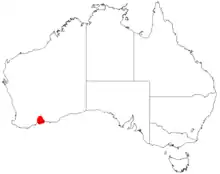Acacia ophiolithica
Acacia ophiolithica is a shrub of the genus Acacia and the subgenus Plurinerves where it is endemic to a small area along the south west coast of Australia.
| Acacia ophiolithica | |
|---|---|
| Scientific classification | |
| Kingdom: | Plantae |
| Clade: | Tracheophytes |
| Clade: | Angiosperms |
| Clade: | Eudicots |
| Clade: | Rosids |
| Order: | Fabales |
| Family: | Fabaceae |
| Clade: | Mimosoideae |
| Genus: | Acacia |
| Species: | A. ophiolithica |
| Binomial name | |
| Acacia ophiolithica | |
 | |
| Occurrence data from AVH | |
Description
The dense rounded shrub typically grows to a height of 0.3 to 2 metres (1 to 7 ft)[1] and has glabrous branchlets that are scarred with raised stem-projections for fallen phyllodes. Like most species of Acacia it has phyllodes rather than true leaves, The slender, straight, glabrous and evergreen phyllodes are ascending to erect but are quite congested. The phyllodes are 1.5 to 4.5 cm (0.59 to 1.77 in) in length and have a diameter of 0.7 to 1 mm (0.028 to 0.039 in) and have four to eight indistinct nerves.[2] It blooms from August to October and produces yellow flowers.[1]
Taxonomy
The species was first formally described by the botanists Richard Sumner Cowan and Bruce Maslin in 1995 as a part of the work Acacia Miscellany. Five groups of microneurous species of Acacia (Leguminosae: Mimosoideae: section Plurinerves), mostly from Western Australia as published in the journal Nuytsia. It was reclassified as Racosperma ophiolithicum by Leslie Pedley in 2003 then transferred back to genus Acacia in 2014.[3] The species belong to the Acacia fragilis group but is most closely related to Acacia uncinella[2] with which it is often confused with.[3]
Distribution
It is native to an area along the south coast of the Goldfields-Esperance region of Western Australia where it is commonly situated along river banks and in rocky areas growing in loamy or clay-loam soils.[1] The plant has a limited range but is common in the area it is found around the Jerdacuttup River to the east of the town of Ravensthorpe where it is commonly a part of mallee Eucalyptus communities but also forms dense stands.[2]
See also
References
- "Acacia ophiolithica". FloraBase. Western Australian Government Department of Parks and Wildlife.
- "Acacia ophiolithica R.S.Cowan & Maslin". Wattle - Acacias of Australia. Lucid Central. Retrieved 23 December 2020.
- "Acacia ophiolithica R.S.Cowan & Maslin". Atlas of Living Australia. Global Biodiversity Information Facility. Retrieved 24 December 2020.